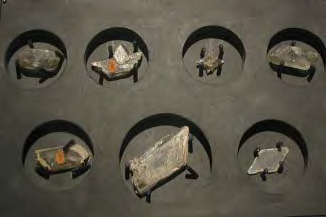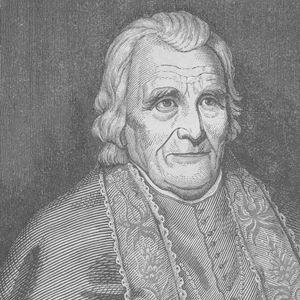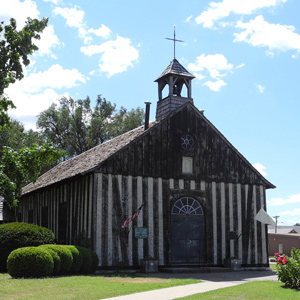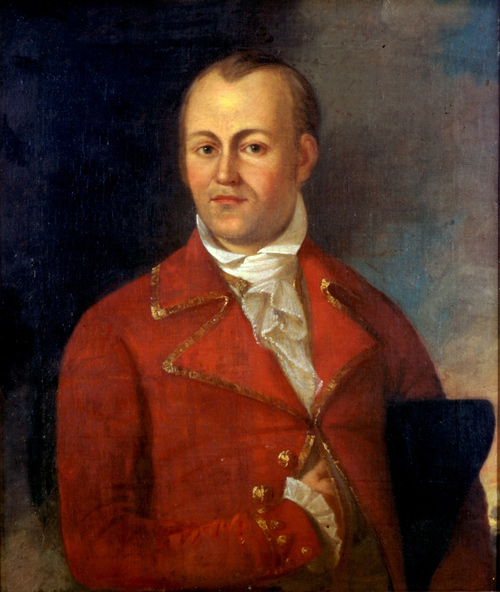August Chouteau and his half-brother Pierre dominated the St. Louis-based fur trade when the Lewis and Clark Expedition arrived in 1803. Auguste is sometimes referred to as René Auguste, the same name as his father, the co-founder of St. Louis. In their seminal work on the Chouteaus, Foley and Rice explained the family’s position in American history:
Described variously as the “Royal Family of the Wilderness,” the “First Citizens of Upper Louisiana,” and the “Founding Family of St. Louis,” this distinguished clan of merchant-capitalists assumed an active and vital role in opening the trans-Mississippi West.[1]William E. Foley and C. David Rice, The First Chouteaus: River Barons of Early St. Louis (Urbana: University of Illinois Press, 1983), ix.
On 28 December 1809, Toussaint Charbonneau and Sacagawea were in a St. Louis vertical log church to baptize their son Jean Baptiste Charbonneau. Auguste Chouteau and his daughter Eulalie signed the baptismal record, and Auguste is listed by the priest as the child’s godfather. Clark would likely have been there, but he was in Washington City at the time.[2]See on this site The Charbonneaus in St. Louis.
Auguste continued working closely with Clark. In 1815, Indian Commissioners William Clark, Ninian Edwards, and Auguste Chouteau completed treaties with a dozen nations meeting at Portage des Sioux just north of St. Louis. By 1820, Auguste and Clark would conclude fifteen more for a total of twenty-seven treaties.[3]Stan Hoig, The Chouteaus: First Family of the Fur Trade (Albuquerque: University of New Mexico Press, 2008), 261–63.
Related Pages


Although not nearly as celebrated as their botanical and zoological work, Lewis and Clark collected a multitude of mineralogical specimens throughout the expedition.
May 18, 1804
Shifting the cargo


Based on what was learned coming up the Missouri, Clark shifts weight to the front of the boats. Drouillard leaves for St. Louis where Lewis is working. Some of the men dance with St. Charles ladies.
May 20, 1804
Sunday in St. Charles


Lewis and a delegation of distinguished citizens leave St. Louis. During a thunderstorm, they shelter in a little cabin. Already in St. Charles, many of the enlisted men attend Catholic mass.
May 31, 1804
Osage disbelief


Strong winds force the expedition to remain near present-day Chamois, Missouri. Some traders heading down report that the Osage People do not believe that their homeland is now part of the United States.
September 6, 1806
A taste of whiskey


Moving down the Missouri along the present Nebraska-Iowa border, the expedition meets a large boat owned by Auguste Chouteau of St. Louis. Some men trade beaver skins for linen shirts and woven hats.
September 12, 1806
Given up for dead


At present St. Joseph, Missouri, the captains modify orders given to Pierre Dorion and Joseph Gravelines. An old military companion, Robert McClellan, says that they have all been given up for dead.
The Charbonneaus in St. Louis
by Robert J. Moore

In 1809, Toussaint, Sacagawea, and Jean Baptiste Charbonneau traveled to St. Louis. Jean Baptiste’s baptism began a new era in his life, is father would try to become a farmer, and Sacagawea would become sickly.
Notes
| ↑1 | William E. Foley and C. David Rice, The First Chouteaus: River Barons of Early St. Louis (Urbana: University of Illinois Press, 1983), ix. |
|---|---|
| ↑2 | See on this site The Charbonneaus in St. Louis. |
| ↑3 | Stan Hoig, The Chouteaus: First Family of the Fur Trade (Albuquerque: University of New Mexico Press, 2008), 261–63. |
Experience the Lewis and Clark Trail
The Lewis and Clark Trail Experience—our sister site at lewisandclark.travel—connects the world to people and places on the Lewis and Clark Trail.
Discover More
- The Lewis and Clark Expedition: Day by Day by Gary E. Moulton (University of Nebraska Press, 2018). The story in prose, 14 May 1804–23 September 1806.
- The Lewis and Clark Journals: An American Epic of Discovery (abridged) by Gary E. Moulton (University of Nebraska Press, 2003). Selected journal excerpts, 14 May 1804–23 September 1806.
- The Lewis and Clark Journals. by Gary E. Moulton (University of Nebraska Press, 1983–2001). The complete story in 13 volumes.


